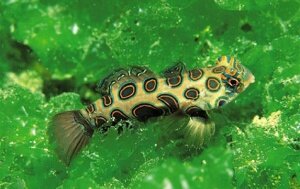Breeding the Spotted Mandarin
From Microcosm Aquarium Explorer

- 1. Spotted mandarin egg, 30 minutes after fertilization. Matthew Wittenrich

- 2. Two cells cleave into four.... Matthew Wittenrich
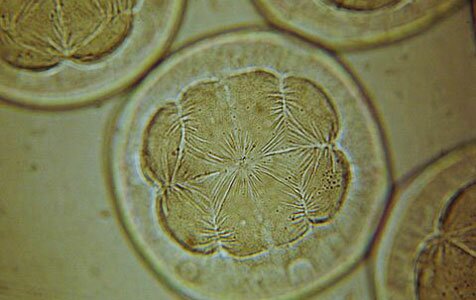
- 3. Four become eight.... Matthew Wittenrich

- 4. Morula stage, with 10-30 cells. Matthew Wittenrich
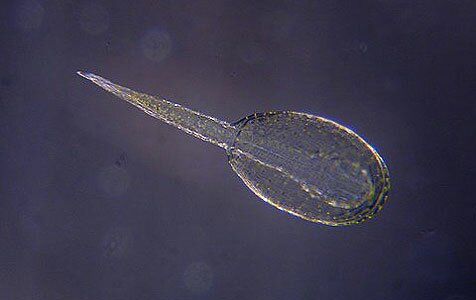
- 5. 13 hours afters spawning: Just-hatched pro-larva. Matthew Wittenrich

- 6. Spotted mandarin larva, 3 days after hatching. Matthew Wittenrich
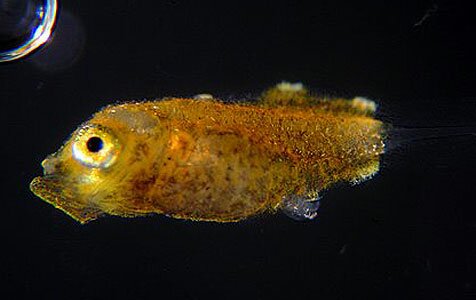
- 6. Spotted mandarin larva, 5 days after hatching. Matthew Wittenrich
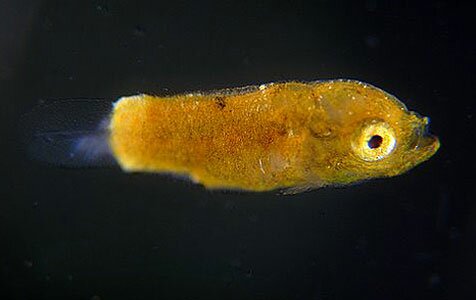
- 6. Spotted mandarin larva, 8 days after hatching. Matthew Wittenrich
You Can't Breed the Greens without Trying the Spotteds
By Matthew L. Wittenrich
After a 14-year hiatus of keeping mandarins, I must admit, they are slowly creeping up on my list of favorite fish.
Having met success in rearing large numbers of the Green Mandarin, Synchiropus splendidus, I decided to try the Spotted Mandarin, Synchiropus picturatus.
My motivation is being driven partly by photography; I have a vision. You know the images of dozens of Tridacna clams in different colors and sizes, squished together with their mantles touching? Yep, I want a picture of mandarins; Greens and Spotteds, all captive-raised and squished together to form a puzzle your grandfather couldn't figure out. A picture that says "Wow".
Coolest Fish in the House
But, as always, a vision is far from the final product, so I thought I would share a bit of my struggle to get the image. It hasn't happened yet, but I am hopeful and continue to snap some shots along the way.
Though somewhat similar to the Greens, Spotteds offer something entirely different. At first, it is the color and psychedelic pattern of this fish that commands attention. Mint green with orange bullseyes, a striking fish for sure. But, after a time, it is their personality that shines through and earns them a spot on the list of family favorites. Both species of mandarins are undeniably popular in the aquarium trade, but recently, my Spotteds hold the rank of coolest fish in the house.
The spotted mandarins sleep together, perched in the same rock, every night. They forage the tank side by side and are quite active in hunting frozen foods from the water column. Spotteds seem a bit easier to train to frozen fare and often take frozen mysids straight out of the pet shop.
Sure, weaning is sometimes necessary and the "Matt Pedersen, Put Them in a Breeder Box and Feed Them Live Artemia Until They Take Frozen Trick" works wonders. (See: Breeding the Green Mandarin.)
Broodstock Struggles
I am bit embarrassed, more for my pocketbook than anything, but I have spent a small fortune on obtaining a few healthy pairs of spotted mandarins. Potential broodstock choices are always limited at local fish shops and most mandarins available are emaciated.
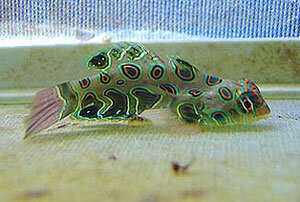
The degree of emaciation varies widely, but most are hurting for sure. I was successful in bringing a few really skinny females back to good health using live mysids to boost them up quickly, but lost quite a few that just couldn't seem to get their energy back. My favorite pair of Spotted Mandarins was given to me by two ambitious undergrad students at Florida Tech. Tim Morrissey and Ian Macdonald have formed quite a few pairs of spawning fish, including Marine Bettas (Comet), and left them in my care over the summer.
I took the pair of Spotted Mandarins home to a 28-gallon tank, fed them well and left them alone. Within a month they began rising into the water column, side by side, under the actinic lights.
The first spawn was very small, maybe 50 or so eggs. I collected them in a small cup and brought them to the lab to incubate and try my hand at rearing. Well, I accidentally spilled the cup and most of the eggs onto the floor. I dumped the remaining 3 eggs into a tank full of Green Mandarins and thought it would a neat surprise if they hit metamorphosis.
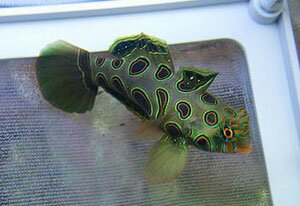
A few days ago, they spawned again. This time, I made sure not to spill them and was able to capture the process of eggs developing, hatching, and the larvae developing. It's one small step among many to bring a tank full through. More to come....
CAPTIONS
- 1. Spotted mandarin egg roughly 30 minutes after fertilization. The single cell cleaves into two.
- 2. Within a short time the two cells cleave into four....
- 3. And then 8....
- 4. The morula stage results from continued cell division and generally contains 10 - 30 cells.
- 5. Hatching in the spotted mandarins occurs roughly 13 hours after fertilization. Very similar to the Green Mandarin, their pro larvae lack eyes, mouth, and digestive tract and exhibit bright yellow xanthophores. Supported by an enormous yolk, the larvae simply drift with motionless with the current giving a good tail burst every few minutes to bring them back up in the water column.
- 6. Spotted mandarin larva at 3 days after hatching. The eyes are fully pigmented, the mouth is open and the digestive tract is open. This is the first feeding stage. Tiny, but bright yellow they are under 2mm in total length.
- 7. Larva at 5 days after hatching.
- 8. Larva at 8 days after hatching.
See also:
Marine Breeder's Forum: MOFIB









